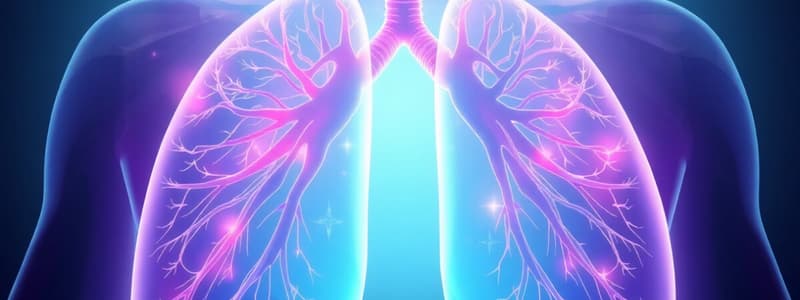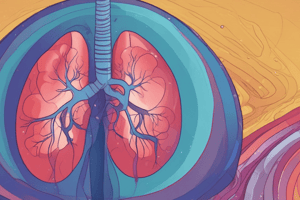Podcast
Questions and Answers
What is the primary factor influencing the elastic recoil of the lungs?
What is the primary factor influencing the elastic recoil of the lungs?
- Breathing rate
- Airway pressure
- Lung compliance
- Alveolar surface tension (correct)
Which condition is likely to decrease lung compliance?
Which condition is likely to decrease lung compliance?
- Asthma
- Chronic bronchitis
- Pulmonary fibrosis (correct)
- Pneumonia
What does compliance refer to in the context of lung behavior?
What does compliance refer to in the context of lung behavior?
- The volume of air exchanged in a normal breath
- The ability of the lungs to recoil after being stretched
- The change in lung volume per unit change in airway pressure (correct)
- The speed of airflow during expiration
What role do elastin fibers play in lung function?
What role do elastin fibers play in lung function?
How does the elastic behavior of the lungs occur during expiration?
How does the elastic behavior of the lungs occur during expiration?
What is the primary function of the pulmonary alveoli?
What is the primary function of the pulmonary alveoli?
Which type of cells in the alveoli are responsible for secreting surfactant?
Which type of cells in the alveoli are responsible for secreting surfactant?
What is the primary role of surfactant in the alveoli?
What is the primary role of surfactant in the alveoli?
How much of the inspired air volume typically remains in the respiratory tract during exhalation?
How much of the inspired air volume typically remains in the respiratory tract during exhalation?
What kind of epithelium is primarily found in the pulmonary alveoli?
What kind of epithelium is primarily found in the pulmonary alveoli?
What is the composition of the 'air-blood' barrier found in the alveoli?
What is the composition of the 'air-blood' barrier found in the alveoli?
What effect does surface tension have on the alveoli during breathing?
What effect does surface tension have on the alveoli during breathing?
Which of the following best describes the condition of the alveoli without surfactant?
Which of the following best describes the condition of the alveoli without surfactant?
What is the primary role of pulmonary surfactant in the alveoli?
What is the primary role of pulmonary surfactant in the alveoli?
Which of the following is a major component of pulmonary surfactant?
Which of the following is a major component of pulmonary surfactant?
What benefit does pulmonary surfactant provide regarding lung mechanics?
What benefit does pulmonary surfactant provide regarding lung mechanics?
How does pulmonary surfactant help in stabilizing the alveoli?
How does pulmonary surfactant help in stabilizing the alveoli?
Which proteins are included in the composition of pulmonary surfactant?
Which proteins are included in the composition of pulmonary surfactant?
What effect do unsaturated phospholipids and cholesterol have on pulmonary surfactant?
What effect do unsaturated phospholipids and cholesterol have on pulmonary surfactant?
What percentage of pulmonary surfactant is composed of surfactant proteins?
What percentage of pulmonary surfactant is composed of surfactant proteins?
What is one of the defense mechanisms provided by pulmonary surfactant?
What is one of the defense mechanisms provided by pulmonary surfactant?
What is the primary structure responsible for the storage and secretion of pulmonary surfactant?
What is the primary structure responsible for the storage and secretion of pulmonary surfactant?
At what gestational age do lamellar bodies first appear in the cytoplasm?
At what gestational age do lamellar bodies first appear in the cytoplasm?
What is tubular myelin thought to function as in the alveolar space?
What is tubular myelin thought to function as in the alveolar space?
What is the estimated alveolar storage pool of surfactant in full-term infants?
What is the estimated alveolar storage pool of surfactant in full-term infants?
Which surfactant protein is particularly associated with the assembly of tubular myelin?
Which surfactant protein is particularly associated with the assembly of tubular myelin?
How is surfactant secreted into the alveolar lining fluid?
How is surfactant secreted into the alveolar lining fluid?
During which process do surfactant phospholipids form lattice-like arrays?
During which process do surfactant phospholipids form lattice-like arrays?
What is the estimated amount of surfactant in preterm infants at birth?
What is the estimated amount of surfactant in preterm infants at birth?
What role do collectins like SP-A and SP-D play in the body?
What role do collectins like SP-A and SP-D play in the body?
What is a key structural feature of SP-A?
What is a key structural feature of SP-A?
What happens to infants born with a congenital absence of SP-B?
What happens to infants born with a congenital absence of SP-B?
Where does surfactant production primarily occur in the lungs?
Where does surfactant production primarily occur in the lungs?
Which surfactant proteins are known to be hydrophobic membrane proteins?
Which surfactant proteins are known to be hydrophobic membrane proteins?
What is the main function of SP-B and SP-C in surfactant dynamics?
What is the main function of SP-B and SP-C in surfactant dynamics?
What do lamellar bodies store in type II cells?
What do lamellar bodies store in type II cells?
How do SP-B and SP-C traffic to the lamellar body during production?
How do SP-B and SP-C traffic to the lamellar body during production?
What is the primary cause of respiratory distress syndrome (RDS) in newborn preterm babies?
What is the primary cause of respiratory distress syndrome (RDS) in newborn preterm babies?
How is most of the surfactant DPPC recycled back into the lungs?
How is most of the surfactant DPPC recycled back into the lungs?
What is a key therapeutic strategy for managing the risk of preterm delivery?
What is a key therapeutic strategy for managing the risk of preterm delivery?
What happens to surface tension in the lungs in the absence of sufficient surfactant?
What happens to surface tension in the lungs in the absence of sufficient surfactant?
Which surfactant preparation is derived from cow lung?
Which surfactant preparation is derived from cow lung?
What is the function of nitric oxide (NO) within the human body?
What is the function of nitric oxide (NO) within the human body?
What is unique about the pulmonary surfactant preparations?
What is unique about the pulmonary surfactant preparations?
Which delivery method is associated with a higher risk of respiratory distress syndrome in newborns?
Which delivery method is associated with a higher risk of respiratory distress syndrome in newborns?
Flashcards
Lung Elasticity
Lung Elasticity
The ability of the lungs to expand and return to their original shape during breathing.
Lung Compliance
Lung Compliance
The change in lung volume for each unit change in airway pressure. It's how easily lungs can be stretched.
Stiff Lung
Stiff Lung
A lung that is stiff and does not stretch easily. This happens in conditions like pulmonary fibrosis.
Elastic Recoil of Lungs
Elastic Recoil of Lungs
Signup and view all the flashcards
Elastin Fiber
Elastin Fiber
Signup and view all the flashcards
Pulmonary Alveoli
Pulmonary Alveoli
Signup and view all the flashcards
Inspiration
Inspiration
Signup and view all the flashcards
Expiration
Expiration
Signup and view all the flashcards
Tidal Volume
Tidal Volume
Signup and view all the flashcards
Alveolar-Capillary Pressure Gradient
Alveolar-Capillary Pressure Gradient
Signup and view all the flashcards
Alveolar Epithelium
Alveolar Epithelium
Signup and view all the flashcards
Surfactant
Surfactant
Signup and view all the flashcards
Surface Tension
Surface Tension
Signup and view all the flashcards
Pulmonary Surfactant
Pulmonary Surfactant
Signup and view all the flashcards
Pulmonary Compliance
Pulmonary Compliance
Signup and view all the flashcards
Lung Recoil
Lung Recoil
Signup and view all the flashcards
Dipalmitoylphosphatidylcholine (DPPC)
Dipalmitoylphosphatidylcholine (DPPC)
Signup and view all the flashcards
Surfactant Proteins (SP)
Surfactant Proteins (SP)
Signup and view all the flashcards
Type II Alveolar Cells
Type II Alveolar Cells
Signup and view all the flashcards
Alveoli
Alveoli
Signup and view all the flashcards
SP-B and SP-C Function
SP-B and SP-C Function
Signup and view all the flashcards
SP-B Deficiency
SP-B Deficiency
Signup and view all the flashcards
SP-C Deficiency
SP-C Deficiency
Signup and view all the flashcards
Surfactant Production Site
Surfactant Production Site
Signup and view all the flashcards
Surfactant Component Synthesis
Surfactant Component Synthesis
Signup and view all the flashcards
Surfactant Storage
Surfactant Storage
Signup and view all the flashcards
Surfactant Release
Surfactant Release
Signup and view all the flashcards
Collectin Function
Collectin Function
Signup and view all the flashcards
Lamellar Bodies (LB)
Lamellar Bodies (LB)
Signup and view all the flashcards
Exocytosis of Lamellar Bodies
Exocytosis of Lamellar Bodies
Signup and view all the flashcards
Tubular Myelin (TM)
Tubular Myelin (TM)
Signup and view all the flashcards
Degradation and Recycling of Surfactant
Degradation and Recycling of Surfactant
Signup and view all the flashcards
Surfactant Protein A (SP-A)
Surfactant Protein A (SP-A)
Signup and view all the flashcards
Alveolar Surfactant Storage Pool
Alveolar Surfactant Storage Pool
Signup and view all the flashcards
20 Weeks Gestation
20 Weeks Gestation
Signup and view all the flashcards
100 mg/kg of Surfactant
100 mg/kg of Surfactant
Signup and view all the flashcards
What is surfactant?
What is surfactant?
Signup and view all the flashcards
What is Respiratory Distress Syndrome (RDS)?
What is Respiratory Distress Syndrome (RDS)?
Signup and view all the flashcards
How is surfactant recycled?
How is surfactant recycled?
Signup and view all the flashcards
What does cortisol do for premature lungs?
What does cortisol do for premature lungs?
Signup and view all the flashcards
What is Colfosceril palmitate (Exosurf) used for?
What is Colfosceril palmitate (Exosurf) used for?
Signup and view all the flashcards
What is Beractant (Survanta)?
What is Beractant (Survanta)?
Signup and view all the flashcards
Study Notes
Lung Surfactant
- Surfactant is a mixture of lipids and proteins.
- Surfactant is secreted by Type II pneumocytes.
- Surfactant reduces surface tension in alveoli.
- Prevention of alveolar collapse.
- Improved respiratory function.
- Important for maintaining open alveoli.
Elastic Behavior of the Lungs
- The lungs' elastic behavior is due to elastic connective tissue and alveolar surface tension.
- During inspiration, the lungs expand.
- During expiration, the lungs recoil.
- Compliance is the lung's stretchability, or the change in lung volume per unit change in airway pressure.
- Low compliance indicates a stiff lung, unable to stretch easily.
- Pulmonary fibrosis can reduce lung compliance.
Alveolar Cells
- Type I pneumocytes cover most of the alveolar surface, involved in gas exchange.
- Type II pneumocytes secrete surfactant.
- Important for the efficient functioning of the lungs.
- Alveolar cells comprise two main types.
Elastic Recoil
- Elastic recoil is the speed of lung rebound to its typical shape after stretch.
- Pulmonary elastic behavior is dependent on two components: connective tissues in the lungs, alveolar surface tension.
Pulmonary Elastic Connective Tissues
- Connective tissue in the lungs contains a lot of elastin, fibers surrounding the alveoli.
- This tissue is responsible for the expansion and elastic recoil of the lungs.
- Elastic recoil is necessary for effective breathing.
Pulmonary Alveoli
- Alveoli are the endpoint of the respiratory system.
- Alveoli exchange oxygen and carbon dioxide.
- Alveolar sac is made of alveoli structures.
- Alveoli are responsible for the gas exchange.
- Alveoli are characterized by the presence of a great deal of alveoli/lungs.
Surfactant
- Surfactant is a substance that decreases surface tension.
- Surfactant is a mixture of lipids and proteins.
- Surfactant is produced, stored, and secreted by Type II alveolar cells.
- Surfactant lowers surface tension inside alveoli to prevent collapse.
- Surfactant helps keep alveoli open for effective gas exchange.
- Surfactant is essential for normal lung function.
Surfactant and Alveolar Surface Tension
- Alveoli are lined with fluid causing opposing forces.
- The attractive forces between water molecules cause tension.
- Surfactant lowers alveolar surface tension by working with water molecules that line the alveoli
- It increases pulmonary compliance, lowering the effort needed for lung inflation.
- It prevents lung collapse, maintaining the open structure of alveoli.
Functions of Surfactant
- Surfactant reduces surface tension in alveoli, thus reducing the tendency of lungs to collapse after exhalation.
- Surfactant stabilizes alveoli.
- Provides defense against infection and inflammation via specific proteins.
- Keeps lungs patent (open) and inflated after delivery after the first breath.
- Surfactant increases pulmonary compliance, reducing the work of inflating the lungs.
Composition of Surfactant
- Surfactant is a complex of phospholipids and proteins.
- The major phospholipid is dipalmitoyl phosphatidylcholine (DPPC).
- Other phospholipids and proteins form part of the structure.
- Surfactant proteins (SP-A, SP-B, SP-C, SP-D) play crucial roles.
- Neutral lipids, such as cholesterol, are also present.
Nitric Oxide
- NO is a gas with no cellular storage mechanism.
- NO is the lowest molecular weight human cell product.
- NO is synthesized from arginine by the enzyme NO synthases.
NO in Lungs
- All three isoforms of NO synthases (nNOS, eNOS, iNOS) are expressed in various lung cells.
- NO regulates several functions in the lung, including antiviral, antibacterial, bronchodilatory, vasodialator, and anti-inflammatory effects.
NO Gas Inhalation
- NO inhalation can be therapeutic.
- Results in decreased pulmonary artery pressure and improved perfusion of ventilated lung parts.
Studying That Suits You
Use AI to generate personalized quizzes and flashcards to suit your learning preferences.





